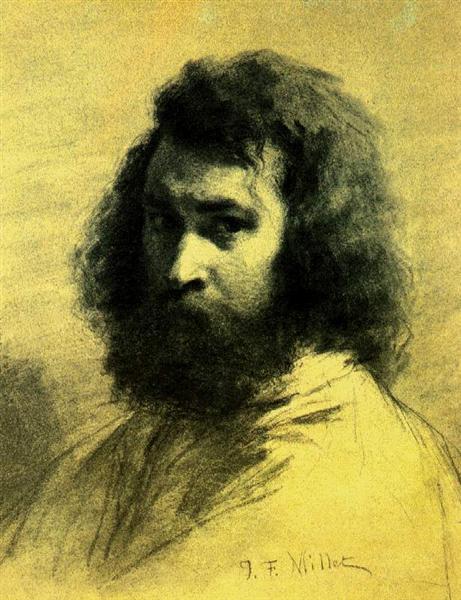Beskrivning
In the world of 19th-century art, Jean-François Millet stands out as a key figure in realism, a movement that advocated the authentic representation of everyday life, especially that of the working classes. His Self-Portrait of 1846 is a work that transcends mere visual assertion and connects us with the essence of the artist and his social context. The painting captures not only Millet's physical appearance, but also his identity as an observer and chronicler of rural life, at a time of profound transformation in France.
The self-portrait reveals a careful composition, in which the artist presents himself with an introspective and, at the same time, powerful air. With a dark and neutral background that focuses attention on his figure, Millet uses a palette of earthy colors, which reinforce his connection with the land and peasant life, environments that he would describe so often in his works. His face, with an expression that is at once serene and reflective, radiates a sense of determination that can be interpreted as a reflection of his commitment to the roots of realism.
The use of light in the painting is also notable. The soft lighting that caresses his face and hands suggests an interest in chiaroscuro, a technique that gives depth and volume to the figure. This light treatment not only emphasizes the painter's facial features, such as his beard and marked features, but also seems to release a sense of humanity and emotional connection. The depiction of his clothing, simple and unadorned, highlights his humility and his proximity to the working classes of which he was a part.
Although the self-portrait lacks additional figures, the absence of secondary characters in the composition allows the viewer's attention to be fully focused on the artist himself. This choice makes the piece a personal statement, a meditation on one's own existence and role in the art world. Importantly, Millet was not seeking personal glorification, but rather an intimate connection with the viewer and a reaffirmation of his life and his art: a visual testimony of his struggle and his convictions.
The depiction of the human figure against the sombre background can also be interpreted as a symbol of the conflict between emerging urban life and declining rural life, themes that dominated the artistic narrative of his time. This self-portrait can be seen as a tribute to peasants and the hard work it represents, aligning itself with his best-known works, such as "The Sower" or "The Gleaners", where the dignity of work becomes the main subject.
In this sense, Millet, through his self-portrait, positions himself not only as an artist who documents the lives of the humble, but also as an intellectual who reflects on his place within the history of art and society. His technique, which consists of an expressive brushstroke and his desire to represent authenticity, resonates with the concerns of his time.
The Self-Portrait - 1846 is, therefore, more than a simple physical representation; it is a connecting vessel between the artist's life and his work, an intimate reflection of an individual immersed in a community, in constant dialogue with the world around him. In this sense, the painting dazzles, not only for its technical execution, but for its relevance in the study of realism and the history of art as a whole.
KUADROS ©, a famous painting on your wall.
Hand-made oil painting reproductions, with the quality of professional artists and the distinctive seal of KUADROS ©.
Painting reproduction service with satisfaction guarantee. If you are not completely satisfied with the replica of your painting, we will refund 100% of your money.

